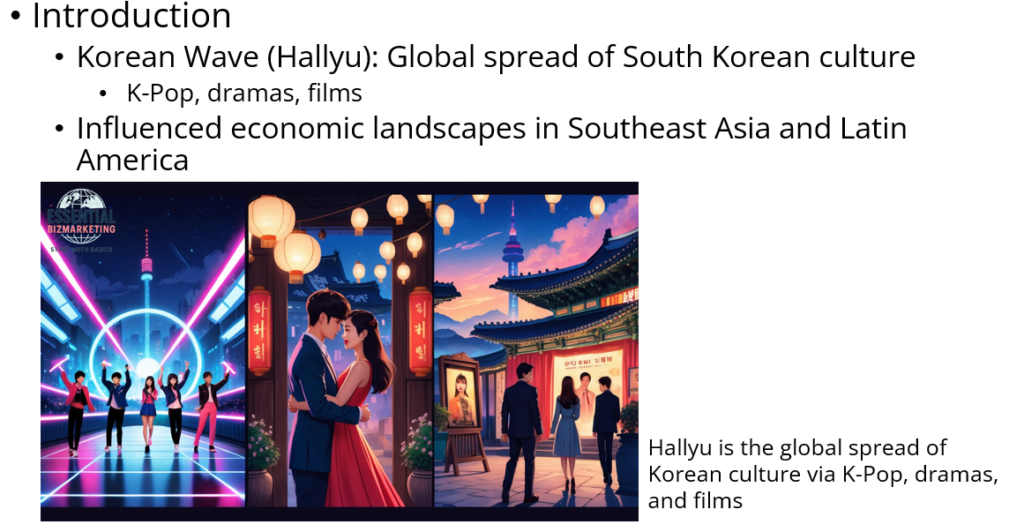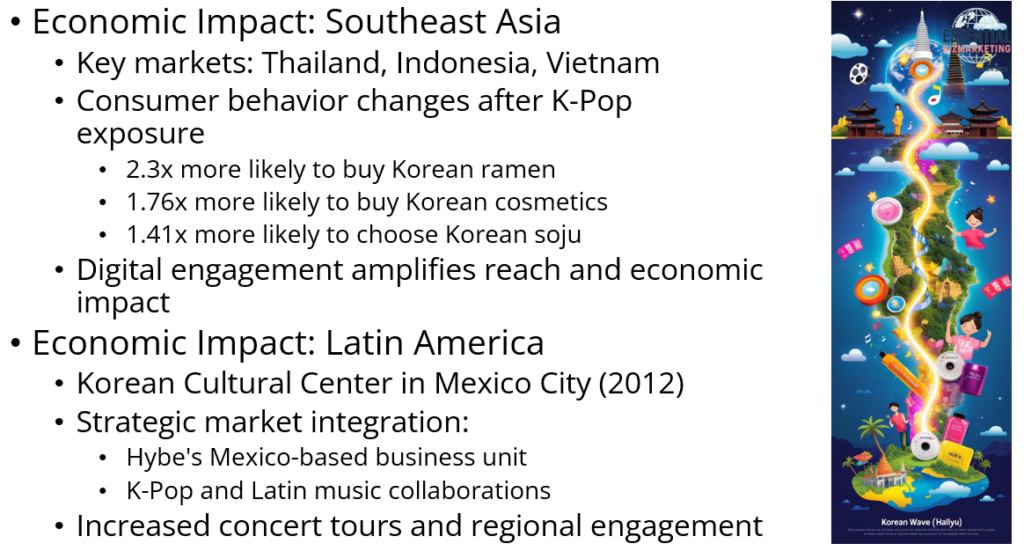Introduction: The Korean Wave’s Global Reach

The Korean Wave, or Hallyu, refers to the global proliferation of South Korean culture, notably through K-Pop music, dramas, and films. This cultural phenomenon has not only elevated South Korea’s cultural standing but has also influenced economic landscapes in various regions, particularly in Southeast Asia and Latin America.
Economic Influence in Southeast Asia

Southeast Asia has emerged as a significant market for K-Pop, with countries like Thailand, Indonesia, and Vietnam exhibiting substantial fan bases. This popularity has translated into economic benefits for both South Korea and the host countries. For instance, exposure to K-Pop performances has been linked to increased consumption of Korean products. A study revealed that after watching K-Pop performances, Southeast Asian consumers were 2.3 times more likely to purchase Korean ramen, 1.76 times more likely to buy Korean cosmetics, and 1.41 times more likely to choose Korean soju . Additionally, the region’s robust digital engagement has amplified K-Pop’s reach, with millions of active fans contributing to the genre’s global expansion .
Economic Influence in Latin America
Latin America has also experienced the economic ripple effects of the Korean Wave. The establishment of the Korean Cultural Center in Mexico City in 2012 exemplifies South Korea’s efforts to strengthen cultural ties and monitor the economic impact of Hallyu in the region . K-Pop’s integration into Latin American markets has been strategic, with agencies like Hybe establishing a Mexico-based business unit to serve as a hub for cultivating new artists and content . This move underscores the potential for synergy between K-Pop and Latin music trends, reflecting a broader strategy to tap into the region’s rapid market growth. Furthermore, collaborations between K-Pop artists and Latin American musicians have fostered cross-cultural exchanges, leading to increased concert tours and fan engagement .
Broader Economic Impacts

The influence of the Korean Wave extends beyond entertainment, impacting various sectors such as tourism, fashion, and beauty. In Southeast Asia, the cultural affinity for Korea has led to the proliferation of Korean street food, convenience stores, and beauty products, illustrating how Korea’s cultural appeal has evolved into an industry of its own . This trend has contributed to the growth of local economies by creating jobs and stimulating consumer spending. Moreover, the integration of Southeast Asian creators into the K-Pop industry has further strengthened these economic ties, with local artists bringing unique styles that resonate globally .
Conclusion: The Korean Wave as an Economic Catalyst
The Korean Wave has transcended cultural boundaries to become a catalyst for economic development in emerging markets. In Southeast Asia and Latin America, K-Pop’s popularity has spurred increased consumption of Korean products, bolstered local economies through tourism and retail, and fostered cross-cultural collaborations that enrich the global music scene. As South Korea continues to export its culture, the reciprocal economic benefits in these regions highlight the power of cultural diplomacy and the global interconnectedness of modern economies.
📚 References
Asia Fund Managers. (2022, November 15). K-pop is making billions for South Korea. https://asiafundmanagers.com/kpop-and-economic-impact-on-south-korea/
Euromonitor International. (2023, June 20). K-Wave in Southeast Asia: Impact and strategies. https://go.euromonitor.com/webinar-kwave-in-southeast-asia-impact-and-strategies.html
Herman, T. (2018, May 31). K-pop turns toward Latin American market with collaborations, tours. Forbes. https://www.forbes.com/sites/tamarherman/2018/05/31/k-pop-turns-towards-latin-american-market-with-collaborations-tours/
Kang, S. (2022, December 1). The global K-Pop impact. Middlebury College. https://www.middlebury.edu/language-schools/blog/global-k-pop-impact
Korea Herald. (2023, February 15). Why are K-pop powerhouses advancing into Latin America? The Korea Herald. https://www.koreaherald.com/article/3439952#:~:text=%22Latin%20America%20has%20a%20relatively,-pop%2C%22%20Lim%20added
Korea Research. (2023, April 11). When people in Southeast Asia watch K-pop performances, the probability of purchasing Korean ramen after that is 2.3 times higher than usual. Maeil Business Newspaper. https://www.mk.co.kr/en/economy/11013143
Roll, M. (2021, June 10). Korean Wave (Hallyu) – The rise of Korea’s cultural economy & pop culture. Martin Roll Company. https://martinroll.com/resources/articles/asia/korean-wave-hallyu-the-rise-of-koreas-cultural-economy-pop-culture/
Weverse Magazine. (2020, September 10). K-pop in SEA, SEA in K-pop. https://magazine.weverse.io/article/view/361
📁 Start exploring the Blog
📘 Or learn more About this site
🧵 Or follow along on X (Twitter)
🔎 Looking for sharp perspectives on global trade and markets?
I recommend @GONOGO_Korea as a resource I trust and regularly learn from.
